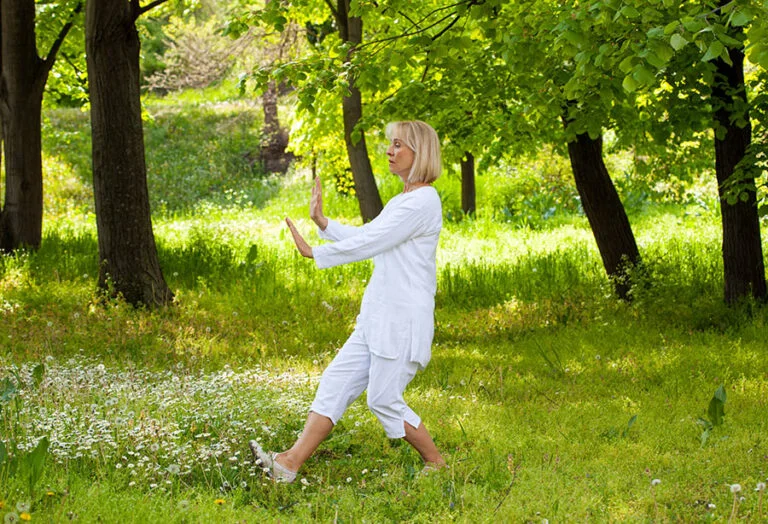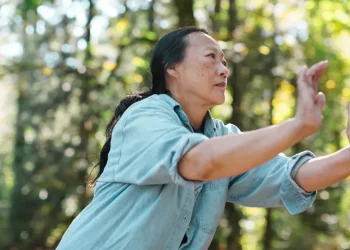Walking is often called the perfect exercise—accessible, free, and beneficial for nearly everyone. But not all walking is created equal. While regular walking has been a cornerstone of fitness recommendations for decades, Tai Chi walking offers a mindful alternative that combines movement with meditation. Understanding the differences between these two approaches can help you choose the practice that best aligns with your health goals, lifestyle, and personal needs.
Understanding the Fundamentals
Regular Walking is the natural locomotion most of us have practiced since childhood. It’s straightforward: one foot in front of the other, typically at a comfortable to brisk pace. Whether you’re walking for transportation, fitness, or leisure, regular walking emphasizes cardiovascular endurance, calorie burning, and forward momentum.
Tai Chi Walking, also known as Tai Chi stepping or mindful walking, is derived from the ancient Chinese martial art of Tai Chi. It’s a deliberate, slow-paced practice that emphasizes body awareness, balance, and the coordination of breath with movement. Rather than focusing on distance or speed, Tai Chi walking prioritizes quality of movement, proper alignment, and present-moment awareness.
Technique: How They Differ
Regular Walking Technique
Regular walking technique is relatively intuitive but can be optimized:
- Pace: Typically ranges from leisurely (2-3 mph) to brisk (3.5-4.5 mph)
- Stride: Natural heel-to-toe rolling motion
- Posture: Upright stance with relaxed shoulders, eyes forward
- Arm movement: Natural swing opposite to leg movement
- Breathing: Usually unconscious, increasing with intensity
- Focus: Often external—enjoying scenery, listening to music, or thinking
The emphasis is on covering distance efficiently while maintaining good form. Brisk walking, in particular, aims to elevate heart rate into a cardiovascular training zone.
Tai Chi Walking Technique
Tai Chi walking transforms walking into a moving meditation:
- Pace: Extremely slow and deliberate, often taking 3-5 seconds per step
- Stride: Heel placement first, followed by mindful weight transfer with the knee bent
- Posture: Deeply intentional—tailbone tucked, spine elongated, crown lifted
- Arm movement: Often coordinated with specific Tai Chi movements or held in particular positions
- Breathing: Synchronized with steps, typically deep abdominal breathing
- Focus: Internal—monitoring body sensations, balance, and energy flow
- Weight distribution: Careful attention to the shifting of weight from one leg to the other, often with a deliberate pause when all weight is on one foot
Each step in Tai Chi walking is performed with complete awareness. Practitioners often describe feeling rooted to the earth while simultaneously maintaining a sense of lightness and flow.
Physical Benefits: What Each Offers
Benefits of Regular Walking
Regular walking, especially when performed briskly, provides robust cardiovascular benefits:
- Heart health: Reduces risk of heart disease and stroke by improving circulation and lowering blood pressure
- Weight management: Burns approximately 200-400 calories per hour depending on pace and body weight
- Bone density: Weight-bearing exercise that helps prevent osteoporosis
- Muscle tone: Engages legs, core, and arm muscles, particularly at faster paces
- Endurance: Builds cardiovascular stamina and aerobic capacity
- Joint health: Low-impact movement that maintains joint flexibility
- Disease prevention: Associated with reduced risk of type 2 diabetes, certain cancers, and chronic diseases
Studies consistently show that 150 minutes per week of moderate-intensity walking can significantly improve overall health outcomes.
Benefits of Tai Chi Walking
Tai Chi walking offers distinct advantages, particularly for balance, body awareness, and rehabilitation:
- Superior balance: The slow, controlled movements significantly improve proprioception and reduce fall risk by up to 45% in older adults
- Enhanced body awareness: Develops deep kinesthetic sense and postural control
- Joint health: Gentle, controlled movements are ideal for arthritis and joint issues
- Neurological benefits: The complex coordination required stimulates brain function and may help with cognitive preservation
- Flexibility: Promotes joint range of motion through controlled, full-range movements
- Stress reduction: The meditative quality significantly lowers cortisol and promotes relaxation
- Core strength: The focus on controlled weight shifts builds deep core stabilizers
- Rehabilitation: Excellent for recovery from injury or surgery due to low impact and controlled pace
While Tai Chi walking burns fewer calories than brisk regular walking (approximately 150-250 per hour), its benefits for balance, body control, and mind-body connection are unparalleled.
Mental and Emotional Benefits
Regular Walking
Regular walking, particularly outdoors, offers significant mental health benefits:
- Reduces symptoms of depression and anxiety
- Boosts mood through endorphin release
- Provides an opportunity for creative thinking and problem-solving
- Can be social when done with others
- Offers exposure to nature and fresh air
- Serves as a break from screen time and daily stressors
Many people find that regular walking provides valuable time to process thoughts, listen to podcasts or music, or simply decompress from daily pressures.
Tai Chi Walking
Tai Chi walking functions as a moving meditation with profound mental benefits:
- Mindfulness cultivation: Trains sustained attention and present-moment awareness
- Stress relief: The meditative quality activates the parasympathetic nervous system
- Anxiety reduction: The focused attention helps quiet racing thoughts
- Emotional regulation: Builds capacity to observe sensations without reactivity
- Mental clarity: The combination of movement and breath promotes cognitive function
- Mind-body integration: Strengthens the connection between physical sensations and mental states
Practitioners often report a sense of calm and centeredness that extends well beyond the practice itself.
Purpose and Philosophy
Regular Walking: Practical Movement
Regular walking serves multiple purposes:
- Transportation: Getting from point A to point B
- Fitness: Cardiovascular exercise and calorie burning
- Recreation: Enjoyment of nature and exploration
- Social activity: Connecting with walking partners or groups
- Goal-oriented: Often tracked by distance, time, steps, or speed
The philosophy of regular walking is straightforward: move your body regularly for health, function, and enjoyment.
Tai Chi Walking: Mindful Practice
Tai Chi walking embodies a different philosophy:
- Quality over quantity: Each step is more important than distance covered
- Internal cultivation: Developing chi (life energy) and body awareness
- Meditation in motion: Walking becomes a contemplative practice
- Present-moment focus: Each step is an opportunity for mindfulness
- Integration: Connecting breath, body, and mind
- Process-oriented: The journey itself is the destination
The philosophy draws from Taoist principles of harmony, balance, and natural flow.
Choosing the Right Approach for You
Regular Walking May Be Best If You:
- Want significant cardiovascular conditioning
- Have weight loss or calorie-burning goals
- Enjoy covering distance and exploring new routes
- Prefer a time-efficient workout
- Like to multitask (listening to music, podcasts, or walking with friends)
- Are training for a walking event
- Want a straightforward, no-frills approach to exercise
- Have limited time for exercise
Tai Chi Walking May Be Best If You:
- Have balance concerns or are at risk for falls
- Are recovering from injury or managing chronic pain
- Experience high stress or anxiety
- Want to develop greater body awareness
- Have joint issues or arthritis
- Are interested in mindfulness or meditation practices
- Prefer quality of movement over quantity
- Have difficulty with higher-impact exercises
- Want to cultivate a deeper mind-body connection
Can You Do Both?
Absolutely! Many people find that incorporating both practices creates a well-rounded movement routine. Consider:
- Regular walking 4-5 days per week for cardiovascular fitness
- Tai Chi walking 2-3 days per week for balance, mindfulness, and recovery
- Using Tai Chi walking as a warm-up or cool-down for regular walks
- Practicing Tai Chi walking indoors during inclement weather
- Alternating based on energy levels and daily needs
Getting Started
Starting Regular Walking
Begin with 10-15 minutes daily and gradually increase duration and intensity. Invest in supportive walking shoes, maintain good posture, and consider using a fitness tracker to monitor progress. Start at a comfortable pace and work toward brisk walking as fitness improves.
Starting Tai Chi Walking
Consider taking a class or watching instructional videos to learn proper technique. Begin with just 5-10 minutes, focusing on one or two steps at a time. Practice in a safe, quiet space where you won’t be distracted. Be patient—the slow pace can be challenging at first for those accustomed to faster movement.
Regular walking and Tai Chi walking aren’t competitors—they’re complementary practices serving different purposes. Regular walking excels at cardiovascular fitness, calorie burning, and practical transportation. Tai Chi walking shines in developing balance, body awareness, mindfulness, and stress reduction.
Your choice depends on your current health status, goals, and what resonates with you personally. If you seek efficiency and cardiovascular benefits, regular walking is ideal. If you need balance work, stress relief, or mindful movement, Tai Chi walking offers unique advantages. And remember: there’s no rule saying you must choose just one.
The best exercise is the one you’ll actually do consistently. Whether you stride briskly through your neighborhood or move with deliberate awareness through Tai Chi steps, you’re making a valuable investment in your health and wellbeing. Listen to your body, honor your needs, and find the walking practice—or combination of practices—that helps you thrive.
- what is tai chi walking compared to regular walking
- understanding tai chi walking difference
- benefits comparison
- technique differences
- principles that make it different
- mindful vs regular walking
- slow mindful vs regular pace
- chi cultivation difference
- meditation component difference
- wellness approach comparison



